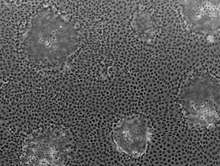Caco-2
The Caco-2 cell line is a continuous line of heterogeneous human epithelial colorectal adenocarcinoma cells, developed by the Sloan-Kettering Institute for Cancer Research through research conducted by Dr. Jorgen Fogh.[1]

History
The application of Caco-2 cells in research was pioneered in the late 1980s by Ismael Hidalgo, working in the laboratory of Ron Borchardt at the University of Kansas, and Tom Raub, who was at the Upjohn Company at the time. Following stints at SmithKline Beecham and Rhone-Poulenc Rorer, Hidalgo went on to co-found a company,[2] in 1996, where he remains as Chief Scientist.
Characteristics
Although derived from a colon (large intestine) carcinoma, when cultured under specific conditions the cells become differentiated and polarized such that their phenotype, morphologically and functionally, resembles the enterocytes lining the small intestine.[3][4] Caco-2 cells express tight junctions, microvilli, and a number of enzymes and transporters that are characteristic of such enterocytes: peptidases, esterases, P-glycoprotein, uptake transporters for amino acids, bile acids, carboxylic acids, etc.
Research Applications
When looking at Caco-2 cell cultures microscopically, it is evident even by visual inspection that the cells are heterogeneous. Over the years, the characteristics of the cells used in different laboratories around the world have diverged significantly, which makes it difficult to compare results across labs.[5] Despite such heterogeneity, Caco-2 cells have found applications in cell invasion studies, viral transfection research, and lipid transport.[6]
Caco-2 cells are most commonly used not as individual cells, but as a confluent monolayer on a cell culture insert filter (e.g., Transwell). When cultured in this format, the cells differentiate to form a polarized epithelial cell monolayer that provides a physical and biochemical barrier to the passage of ions and small molecules.[4][7] The Caco-2 monolayer is widely used across the pharmaceutical industry as an in vitro model of the human small intestinal mucosa to predict the absorption of orally administered drugs with different kits such as the CacoReady.[8] The correlation between the in vitro apparent permeability (P¬app) across Caco-2 monolayers and the in vivo fraction absorbed (fa) is well established.[9]Transwell diagram
See also
- Cell culture
- Drug development
- Pre-clinical development
- PAMPA - a non cell-based permeability assay
References
- Fogh J, Trempe G (1975). "New Human Tumor Cell Lines". In Fogh J (ed.). Human Tumor Cells In Vitro. Plenum. pp. 115–141. ISBN 978-1-4757-1647-4.
- "Absorption Systems". Archived from the original on 2010-05-29.
- Pinto M (1983). "Enterocyte-like differentiation and polarization of the human colon carcinoma cell line Caco-2 in culture". Biol Cell. 47: 323–30.
- Hidalgo IJ, Raub TJ, Borchardt RT (March 1989). "Characterization of the human colon carcinoma cell line (Caco-2) as a model system for intestinal epithelial permeability". Gastroenterology. 96 (3): 736–49. doi:10.1016/0016-5085(89)90897-4. PMID 2914637.
- Sambuy Y, De Angelis I, Ranaldi G, Scarino ML, Stammati A, Zucco F (January 2005). "The Caco-2 cell line as a model of the intestinal barrier: influence of cell and culture-related factors on Caco-2 cell functional characteristics". Cell Biology and Toxicology. 21 (1): 1–26. doi:10.1007/s10565-005-0085-6. PMID 15868485. S2CID 125735.
- Nauli AM, Whittimore JD (August 2015). "Using Caco-2 Cells to Study Lipid Transport by the Intestine". Journal of Visualized Experiments (102): e53086. doi:10.3791/53086. PMC 4692536. PMID 26325673.
- Artursson P (June 1990). "Epithelial transport of drugs in cell culture. I: A model for studying the passive diffusion of drugs over intestinal absorptive (Caco-2) cells". Journal of Pharmaceutical Sciences. 79 (6): 476–82. doi:10.1002/jps.2600790604. PMID 1975619.
- Vázquez-Sánchez MÁ. "CacoReady". Readycell. Readycell. Retrieved 19 July 2018.
- Artursson P, Karlsson J (March 1991). "Correlation between oral drug absorption in humans and apparent drug permeability coefficients in human intestinal epithelial (Caco-2) cells". Biochemical and Biophysical Research Communications. 175 (3): 880–5. doi:10.1016/0006-291X(91)91647-U. PMID 1673839.
Further reading
- Artursson P, Palm K, Luthman K (March 2001). "Caco-2 monolayers in experimental and theoretical predictions of drug transport". Advanced Drug Delivery Reviews. 46 (1–3): 27–43. doi:10.1016/S0169-409X(00)00128-9. PMID 11259831.
- Shah P, Jogani V, Bagchi T, Misra A (2006). "Role of Caco-2 cell monolayers in prediction of intestinal drug absorption". Biotechnology Progress. 22 (1): 186–98. doi:10.1021/bp050208u. PMID 16454510.